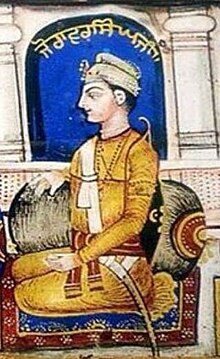Zorawar Singh (Sikhism)
Zorawar Singh | |
|---|---|
ਜ਼ੋਰਾਵਰ ਸਿੰਘ, ਸਾਹਿਬਜ਼ਾਦਾ | |
 Detail of Sahibzada Zorawar Singh from a mural depicting Guru Gobind Singh and his four sons (the Sahibzadas) located within Takht Hazur Sahib | |
| Personal life | |
| Born | 17 November 1696 Anandpur, India |
| Died | 26 December 1704 Fatehgarh Sahib, India |
| Cause of death | Extrajudicial execution by Immurement |
| Parent(s) | Guru Gobind Singh, Mata Jito |
| Relatives | Sahibzada Ajit Singh (half-brother)
Sahibzada Jujhar Singh (brother) Sahibzada Fateh Singh (brother) |
| Religious life | |
| Religion | Sikhism |
Zorawar Singh (Punjabi: ਸਾਹਿਬਜ਼ਾਦਾ ਜ਼ੋਰਾਵਰ ਸਿੰਘ, pronunciation: [säːɦɪbd͡ʒäːd̪ɛ d͡ʒoɾäːʋaɾ sɪ́ŋgᵊ]; 17 November 1696 – 26 December 1704[1]), alternatively spelt as Jorawar Singh,[2] was a son of Guru Gobind Singh who was executed in the court of Wazir Khan, the Mughal Governor of Sirhind.
Background
[edit]In 1699, the Pahari Rajas of the Shiwalik Hills, frustrated with increasing Sikh ascendancy in the region, requested aid from Aurangzeb; their combined forces took on the Khalsa, led by Guru Gobind Singh, at Anandapur but were defeated.[3] Another faceoff followed in the neighboring Nirmoh but ended in Sikh victory; there was probably another conflict in Anandapur (c. 1702) to the same outcome.[3] In 1704, the Rajahs mounted a renewed offensive against Guru Gobind Singh in Anandapur, but facing imminent defeat, requested aid from Aurangzeb.[3] While the Mughal subahdars came to aid, they failed to change the course of the battle.[3] Accordingly, the Rajahs decided to lay siege to the town rather than engage in open warfare.[3]
With the passage of a few uneventful months, as scarcity of food set in, Guru Gobind Singh's men compelled him to migrate; the besiegers guaranteed a safe passage but Guru Gobind Singh did not trust them.[3] The Sikhs eventually left Anandapur in the night and took refuge in Chamkaur, only for its Hindu Zamindar to inform the Rajahs and Mughal authority.[4] In the melee that ensued, Singh escaped but most of his men were either killed or captured.[4]
Death
[edit]
Some Sikh accounts note Singh's two younger sons — Zorawar Singh and Fateh Singh — to have successfully fought at Chamkaur before being captured.[4] Other accounts note that they along with their grandmother had been separated from the Sikh retinue while migrating away from Anandapur; subsequently, they were betrayed by local officials and handed over to the Mughals.[4] Sukha Singh and Ratan Singh Bhangu, in particular, blame a greedy Brahmin for the betrayal.[4]
The sons were taken to Sirhind and coerced for conversion to Islam in the court of Wazir Khan, the provincial governor.[4] Sikh accounts accuse Sucha Nand, the Hindu Diwan, to have been the most vocal advocate for executing the children; Sher Muhammad Khan, the Nawab of Meherkotla, despite being an ally of the Mughals and losing relatives in the faceoff, was the sole dissenter.[4][5] Both of the children maintained a steadfast refusal to convert and were executed, as a result.[4] In early Sikh accounts, they were simply beheaded; in popular Sikh tradition, they are held to have been "bricked" (entombed) alive.[6]
See also
[edit]References
[edit]- ^ Harbans Singh, ed. (1992–1998). The encyclopaedia of Sikhism. Vol. 4. Patiala: Punjabi University. p. 461. ISBN 0-8364-2883-8. OCLC 29703420.
- ^ "The Sikh Review". The Sikh Review. 69: 06 (810): 82. 1 June 2021.
- ^ a b c d e f Grewal, J. S. (2020). "Ouster from Anandpur (1699–1704)". Guru Gobind Singh (1666-1708): Master of the White Hawk. Oxford University Press. ISBN 9780199494941.
- ^ a b c d e f g h Grewal, J. S. (2020). "Negotiations with Aurangzeb (1705–7)". Guru Gobind Singh (1666-1708): Master of the White Hawk. Oxford University Press. ISBN 9780199494941.
- ^ Bigelow, Anna (2010). "The Nawabs: Good, Bad, and Ugly". Sharing the Sacred: Practicing Pluralism in Muslim North India. Oxford University Press. pp. 74–76. ISBN 978-0-19-536823-9.
- ^ Fenech, Louis E. (2013). "Ẓafar-Nāmah, Fatḥ-Nāmah, Ḥikāyats, and the Dasam Granth". The Sikh Ẓafar-nāmah of Guru Gobind Singh: A Discursive Blade in the Heart of the Mughal Empire. Oxford University Press. p. 19. ISBN 9780199931439.
